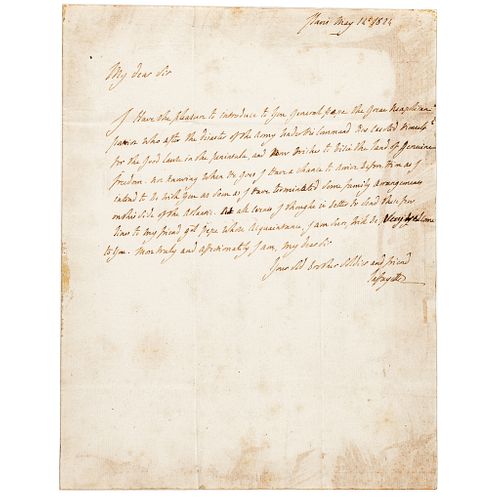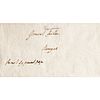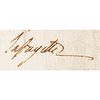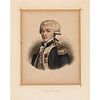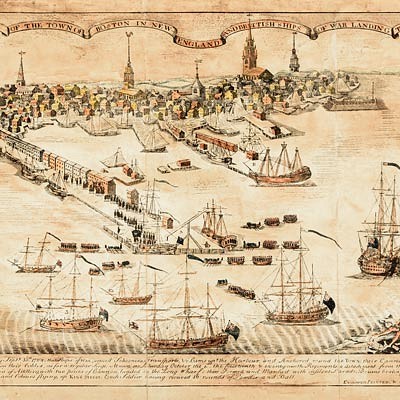1824 MARQUIS DE LAFAYETTE ALS General Pepe's Introduction to Gen. Marinus Willet
Lot 50
Categories
Estimate:
$2,400 - $2,800
Absentee vs Live bid
Two ways to bid:
- Leave a max absentee bid and the platform will bid on your behalf up to your maximum bid during the live auction.
- Bid live during the auction and your bids will be submitted real-time to the auctioneer.
Bid Increments
| Price | Bid Increment |
|---|---|
| $0 | $10 |
| $200 | $20 |
| $300 | $25 |
| $500 | $50 |
| $1,000 | $100 |
| $2,000 | $200 |
| $3,000 | $250 |
| $5,000 | $500 |
| $10,000 | $1,000 |
| $20,000 | $2,000 |
| $30,000 | $2,500 |
| $50,000 | $5,000 |
| $100,000 | $10,000 |
| $200,000 | $20,000 |
| $300,000 | $25,000 |
| $500,000 | $50,000 |
About Auction
By Early American History Auctions
Mar 20, 2021
Set Reminder
2021-03-20 12:00:00
2021-03-20 12:00:00
America/New_York
Bidsquare
Bidsquare : Autographs-Colonial-Political-Americana
https://www.bidsquare.com/auctions/early-american-history-auctions/autographs-colonial-political-americana-6509
330 Lots of Rare, Historic Autographs, Americana, Civil War Era, George Washington, Abraham Lincoln, Slavery & Black History, Revolutionary War Era, Colonial America, Federal Period, War of 1812, Colonial Currency, Indian Peace Medals & more... Early American History Auctions auctions@earlyamerican.com
330 Lots of Rare, Historic Autographs, Americana, Civil War Era, George Washington, Abraham Lincoln, Slavery & Black History, Revolutionary War Era, Colonial America, Federal Period, War of 1812, Colonial Currency, Indian Peace Medals & more... Early American History Auctions auctions@earlyamerican.com
- Lot Description
Autographs
1824 Marquis De Lafayette Autographed Letter Signed with his Introduction of General Pepe, who "now wishes to visit the land of genuine freedom..." to General Marinus Willet
MARQUIS DE LAFAYETTE (1757-1834). French Soldier and Statesman, American Revolutionary War Veteran, Lifelong Friend of George Washington, "The Hero of the Two Worlds."
May 14, 1824-Dated just two months before President James Monroe's Invitation for Lafayette's "Grand Tour" of the United States to begin, Autograph Letter Signed, "Lafayette", nicely written in brown ink, Choice Very Fine. This great content Signed Letter is written completely in his hand along with a later color Portrait of Lafayette on heavy wove print paper. This Signed Letter measures 7.25" x 9.25" and is composed of four pages with writing on the first, blank pages on the second and third, and a docket on the fourth page. Well written on laid period paper, there is light show-through evidence of previous heavy edge mounting emanating from the fourth/back page of this letter, where the central Integral Transmittal Cover remains perfectly clean and clear, the outer edges with residue. The Portrait measures about 4" x 5" and is printed on a larger heavy print paper c. 1850 with "Lafayette" printed underneath.
In this wonderful content Letter, Lafayette recommends introduction of the noted Italian patriot and solider, General Pepe to American Revolutionary War General Marinus Willett (1740-1830) of New York, characterized by historian Mark M. Boatner as "one of the truly outstanding American leaders of the Revolution." Dated only two months before President James Monroe's invitation for Lafayette's "Grand Tour" of the United States which began in July 1824, setting up introductions for General Pepe while accompanying him in America. This Signed Letter is written fully in Lafayette's own hand, with Intergal Address Cover written to "General Willett - New York" noted, "favour'd by General Pepe." This heartfelt personal Letter reads, in full:
"Paris - May 14 1824 --- My Dear Sir --- I Have the pleasure to introduce to you General Pepe the great Neapolitan patriot who after the disaster of the army under his command had exerted himself for the good cause in the peninsula, and now wishes to visit the land of genuine freedom. Not knowing when he goes I have a chance to arrive before him as I intend to be with you as soon as I have terminated some family arrangements on this side of the Atlantic. But as friends I thought it better to send these few lines to my friend Gnl Pepe whose acquaintance, I am sure, will be Very Welcome to you. - Most truly and affectionately I am, My dear Sir --- Your old brother Soldier and friend - (Signed) Lafayette".
General Willett was one of Lafayette's dearest friends in America. The Saturday Evening Post had this to say about the friendship between Lafayette and Willett in their issue from August 21, 1824, the day Lafayette arrived in New York on his Grand Tour: "Decidedly the most interesting sight was the [New York] reception of the General by his old companions in arms: Colonel Marinus Willet[sic], now in his eighty-fifth year, General Van Cortland, General Clarkson, and the other worthies whom we have mentioned... He embraced them all affectionately, and Col. Willet again and again. He knew and remembered them all. It was a re-union of a long separated family. After the ceremony of embracing and congratulations were over, he sat down alongside of Col. Willet, who grew young again and fought all his battles over. "Do you remember," said he, "at the battle of Monmouth, I was volunteer aid to Gen. Scott ? I saw you in the heat of battle. You were but a boy, but you were a serious and sedate lad. Aye, aye; I remember well. And on the Mohawk, I sent you fifty Indians. And you wrote me, that they set up such a yell that they frightened the British cavalry, and they ran one way and the Indians another."
No person who witnessed this interview will ever forget it; many an honest tear was shed on the occasion. The young men retired at little distance, while the venerable soldiers were indulging recollections, and were embracing each other again and again... Such sincere, such honest feelings, were never more plainly or truly expressed. The sudden changes of the countenance of the Marquis, plainly evinced the emotions he endeavored to suppress. When a Revolutionary story from the venerable Willet recalled circumstance long passed, the incident... made the Marquis sigh; and his swelling heart was relieved when he burst into tears."
This very moving piece of history expressed the deep affection shared between Lafayette and Marinus Willett. This introduction of a compatriot in Liberty, such as the popular General Pepe, and the timing of this Letter coincide with Lafayette's "Grand Tour" and the reported reunion with General Willet is a historic combination rarely seen so documented. We located a similar Letter of introduction for General Pepe (albeit it less affectionate in nature), addressed to John Quincy Adams, which sold at auction in December 2009 for $2,448. A wonderful historic Letter of Introduction between three Patriotic Generals. (2 items)
Marie-Joseph Paul Yves Roch Gilbert du Motier, Marquis de La Fayette (6 September 1757 - 20 May 1834), known in the United States as Lafayette, was a French aristocrat and military officer who fought in the American Revolutionary War, commanding American troops in several battles, including the Siege of Yorktown. After returning to France, he was a key figure in the French Revolution of 1789 and the July Revolution of 1830. He has been considered a national hero in both countries.
Lafayette was born into a wealthy land-owning family in Chavaniac in the province of Auvergne in south central France. He followed the family's martial tradition and was commissioned an officer at age 13. He became convinced that the American revolutionary cause was noble, and he traveled to the New World seeking glory in it. He was made a major general at age 19, but he was initially not given American troops to command.
He was wounded during the Battle of Brandywine but still managed to organize an orderly retreat, and he served with distinction in the Battle of Rhode Island. In the middle of the war, he sailed for home to lobby for an increase in French support. He returned to America in 1780 and was given senior positions in the Continental Army. In 1781, troops under his command in Virginia blocked forces led by Cornwallis until other American and French forces could position themselves for the decisive Siege of Yorktown.
Lafayette returned to France and was appointed to the Assembly of Notables in 1787, convened in response to the fiscal crisis. He was elected a member of the Estates General of 1789, where representatives met from the three traditional orders of French society: the clergy, the nobility, and the commoners.
After forming the National Constituent Assembly, he helped to write the Declaration of the Rights of Man and of the Citizen with Thomas Jefferson's assistance. This document was inspired by the United States Declaration of Independence and invoked natural law to establish basic principles of the democratic nation-state. He also advocated the end of slavery, in keeping with the philosophy of natural rights.
After the storming of the Bastille, he was appointed commander-in-chief of France's National Guard and tried to steer a middle course through the years of revolution. In August 1792, radical factions ordered his arrest, and he fled into the Austrian Netherlands. He was captured by Austrian troops and spent more than five years in prison.
Lafayette returned to France after Napoleon Bonaparte secured his release in 1797, though he refused to participate in Napoleon's government. After the Bourbon Restoration of 1814, he became a liberal member of the Chamber of Deputies, a position which he held for most of the remainder of his life.
In 1824, President James Monroe invited him to the United States as the nation's guest, and he visited all 24 states in the union and met a rapturous reception. During France's July Revolution of 1830, he declined an offer to become the French dictator. Instead, he supported Louis-Philippe as king, but turned against him when the monarch became autocratic. He died on 20 May 1834 and is buried in Picpus Cemetery in Paris, under soil imported from Bunker Hill. He is sometimes known as "The Hero of the Two Worlds" for his accomplishments in the service of both France and the United States.
General Guglielmo Pepe (1783 - 1855) was an Italian General and Patriot. He entered the army at an early age, but in 1799 he took part in the Neapolitan Republic, inspired by the French Revolution.
While fighting against the Bourbon troops, which were led by Cardinal Ruffo, he was captured and exiled to France. He entered Napoleon's army and served with distinction in several campaigns, including those in the Neapolitan kingdom: first under Joseph Bonaparte, and later under Joachim Murat.
After commanding a Neapolitan brigade in the Peninsular campaign, Pepe returned to Italy in 1813, with the rank of General, to help reorganize the Neapolitan army. When news of the fall of Napoleon (1814) reached Italy, Pepe and several other Generals tried without success, to force Murat to grant a constitution as the only means of saving the kingdom from foreign invasion and the return of the Bourbons.
On Napoleon's escape from Elba (1815) Murat, after some hesitation, placed himself on the emperor's side and waged war against the Austrians, with Pepe on his staff. After several engagements the Neapolitans were forced to retire after the Battle of Tolentino (in which Pepe participated), and eventually agreed to the Treaty of Casalanza, according to which Murat was to abandon the kingdom; but the Neapolitan officers retained their rank under Ferdinand IV, who now regained the throne of Naples.
While engaged in suppressing brigandage in the Capitanata, Pepe organized the carbonari into a national militia, intending to use them for political purposes. He had hoped that the king would grant a constitution; but when that hope failed he contemplated seizing Ferdinand, the emperor of Austria, and Metternich, who were expected at Avellino, in order to compel them to install a liberal constitution in Italy (1819). The scheme broke down through an accident, but in the following year a military rising broke out, the mutineers cheering for the king and the constitution.
General Pepe himself was sent against them; but while he was deciding on which course to follow, Ferdinand promised a constitution (July 1820). A revolt in Sicily having been repressed, Pepe was appointed Inspector-General of the army.
Meanwhile, the King, who had no intention of respecting the constitution, went to the Congress of Laibach to confer with the sovereigns of the holy alliance assembled there, leaving his son as regent. The king obtained the loan of an Austrian army with which to restore absolute power, while the regent dallied with the Liberals.
Pepe, who in parliament had spoken in favour of deposing the King, now took command of the army and marched against the Austrians. He attacked them at Rieti (March, 1821), but his raw levies were repulsed.
The army was gradually disbanded. Pepe then spent several years in England, France and other countries, publishing a number of books and pamphlets of a political character and keeping up his connection with the Carbonari. When the 1848 revolution and war broke out all over Italy, Pepe returned to Naples, where a constitution had again been proclaimed. He was given command of the Neapolitan army, which was to co-operate with Piedmont against the Austrians. However, when he reached Bologna, the King, who had already changed his mind, recalled him and his troops.
Pepe, after hesitating between his desire to fight for Italy and his oath to the King, resigned his commission in the Neapolitan service and crossed the Po River with 2,000 volunteers to take part in the military campaign. After a good deal of fighting in Venetia, he joined Manin in the siege of Venice and took command of the defending army. When the city was forced by hunger to surrender to the Austrians, Pepe and Manin were among those excluded from the amnesty.
Marinus Willett was born in Jamaica, New York, on Long Island, the son of Edward Willett a school teacher and tavern operator.
He served in the militia during the French and Indian War. He received a commission as 2nd lieutenant in a New York regiment under the command of Oliver DeLancey Sr. which took part in General James Abercrombie's expedition to Fort Ticonderoga in 1758. His regiment was part of John Bradstreet's army in the Battle of Fort Frontenac. He became ill and stayed at Fort Stanwix until he recovered.
He graduated from King's College (later Columbia University) and received his A.B. in 1776. Between the wars he also worked as a cabinetmaker. During the early stages of the American Revolution, Willett became an informal leader of the Sons of Liberty in New York City. His main participation was as a rabble-rouser and street brawler.
When news arrived on April 23, 1775 of the battles at Lexington and Concord he and others broke into the New York City arsenal and seized the weapons. On June 6, 1775 when the British soldiers in New York decided to evacuate the city, Willett stopped the soldiers from taking spare arms with them. On July 20, 1775 he and other members of the Sons of Liberty procured a sloop, surprised the guard, and captured a British storehouse at Turtle Bay.
On June 28, 1775, he joined the Continental Army with a commission of captain in the 1st New York Regiment, commanded by Alexander McDougall. Six weeks later the regiment took part in Richard Montgomery's Invasion of Canada (1775) and in December the Battle of Quebec (1775).
In January, 1776 the enlistments in the regiment expired and the men started home. Willett arrived in New York City in March. In the defence of New York City later that year Willett lost a captain's commission in the 4th New York Regiment and participated as a militiaman.
In November, 1776 he was made Lieutenant Colonel of the 3rd New York Regiment which was commanded by Peter Gansevoort. He spent the winter recruiting. In March, 1777 he was given command of Fort Constitution in the New York Highlands. From this fort, he engaged in a successful attack on one hundred British soldiers burning a house. The fort was abandoned when other nearby forts fell. In May, he was transferred to Fort Stanwix to join the rest of his regiment, where he was second in command.
On August 6, 1777, during the Battle of Oriskany he led a sortie from the fort which plundered the nearby Indian and Sir John Johnson's Tory camp. His force suffered no casualties. He was presented with a sword from the Continental Congress for this exploit.
After the American defeat at Oriskany, he and another officer slipped through British lines down the Mohawk to Fort Dayton for help. They only took spontoons as weapons and whiskey, cheese, and crackers for food. At Fort Dayton he learned that Major General Schuyler had already dispatched a second relief force under the command of Benedict Arnold. Willett proceeded to Albany where he met with Arnold and then returned to Fort Dayton with Arnold's army.
On August 20, Willett presided as a judge of Walter Butler who had been captured and was being tried as a spy. Butler was found guilty and sentenced to death. Butler was sent to Albany to await execution. In September, Willett left to visit his wife. While the 3rd New York Regiment was idle spending the winter at Fort Stanwix, virtually all the officers petitioned to be transferred to the main army. Gansevoort gave Willett leave to visit George Washington in Philadelphia and the forts in Connecticut.
In June, 1778 he was given leave to join Washington's' Main Army. He served as an aide to General Charles Scott and took part in the Battle of Monmouth. On March 15, 1779, he was given command of a new militia regiment, a position he neither accepted nor declined. He was second in command of the attack on Onondaga in April, 1779.
In the summer of 1779, he was with the 3rd New York Regiment as it took part in the Sullivan Campaign. Afterward, it was for a short time stationed in the New York Highlands before joining the main army at Morristown. In January, he took part in a raid on Staten Island. This raid appears to be a separate raid from that conducted by Lord Stirling.
In early 1780, he was given command of the 5th New York Regiment a regiment that was severely understrength because of battles in the New York Highlands. In September, he was one of three officers of the New York Line who presented their grievances to the New York legislature. The men had not been paid since January and they asked for compensation in the form of land. He was made a full colonel of the regiment on December 22, 1779. On January 1, 1781 the number of New York regiments was reduced to two, and Willett lost his command. He went home to his wife in Danbury.
In April 1781, he was made a colonel of the militia and given responsibility for the defense of the Mohawk Valley. Although the Tryon County militia was nominally 1,100 men, he did not believe that more than five hundred would turn out. His headquarters were at Fort Plain.
He had about four hundred men which he split between Saratoga, Ballston, German Flatts, Canajoharie, Fort Hunter, Catskill, Johnstown, and Schoharie. By this time Fort Stanwix had been abandoned. Willett wrote of the militia that "I don't think I shall give a very wild account if I say, that one third have been killed, or carried captive by the enemy; one third removed to the interior places of the country; and one third deserted to the enemy"
In July 1781, he led the militia in the Battle of Sharon Springs where he ambushed a force of Indians and Loyalists under the command of John Doxtader. In October, he led the militia against a mixed force under the command of Major John Ross at the Battle of Johnstown. Afterward, the Americans marched to German Flatts as their scouts tracked the retreating force, which had been reduced to eating its horses.
A forced march through a heavy snowstorm brought Willet's force within two miles of the Loyalist camp by nightfall of October 29, but he eschewed a night attack in the storm. Attacking the next morning, he found that the Loyalists had already broken camp. Captain Walter Butler was killed in the pursuit but the Loyalist force dispersed in the forest.
In late 1781, several companies of New Hampshire troops were added to his command. In February, 1783, George Washington directed him to capture Fort Ontario, but Willet's force gave up the attempt when the possibility of surprise was lost.
Washington visited the Mohawk valley in 1783 and he instructed Willett to improve the roads and waterway to Lake Oneida. In October, Willett's troops went home after being disbanded without ceremony.
Our Auction Contents:
Black History & Slavery: (Lots 1 - 63)
Abraham Lincoln Related: (Lots 64 - 74)
Historic Autographs: (Lots 75 - 235)
Colonial America: (Lots 236 - 261)
Revolutionary War: (Lots 262 - 304)
George Washington Related: (Lots 305 - 306)
Early American Guns & Weapons: (Lots 307 - 318) - Shipping Info
-
Early American provides in-house worldwide shipping. Please contact us directly if you have questions about your specific shipping requirements.
-
- Buyer's Premium



 EUR
EUR CAD
CAD AUD
AUD GBP
GBP MXN
MXN HKD
HKD CNY
CNY MYR
MYR SEK
SEK SGD
SGD CHF
CHF THB
THB